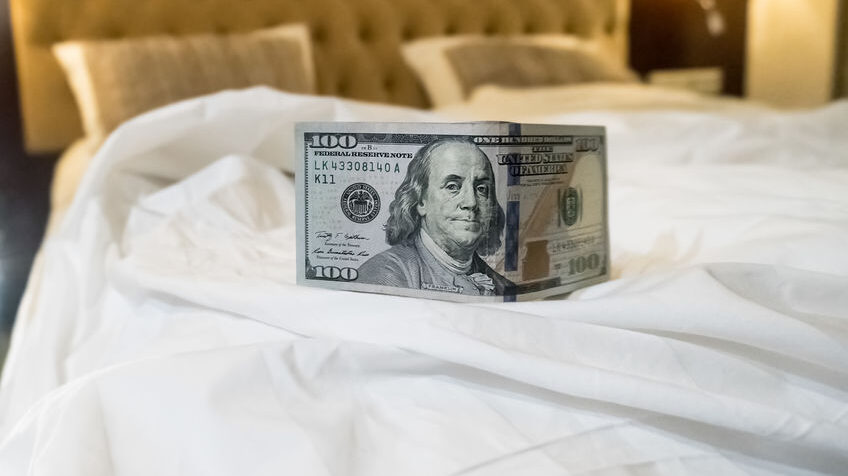How Many Americans Have Paid For Sex Before?
January 23, 2019 by Justin Lehmiller
Purchasing sex used to be a very common behavior among American men. For example, Alfred Kinsey’s famous studies of human sexual behavior from the 1940s and 50s found that 69% of the men he surveyed had paid for sex at least once [1]! However, more recent studies suggest that the number has dropped significantly as attitudes toward sex outside of marriage have liberalized. In fact, in the 1990s, a nationally representative survey of Americans found that just 16% of men said they had paid for sex before [2].
So what do the numbers look like today? And how do they compare for men and women?
A 2016 YouGov national survey of 1,000 American adults age 18+ offers some insight. When asked the question “have you ever paid someone else for sex,” 12% of men said yes compared to 1% of women.
These numbers might be underestimates, though, because 2% of men and 1% of women chose the response option of “prefer not to say,” while another 2% of men said “I don’t know.” I would hypothesize that many of the people who chose these options have indeed paid for sex but didn’t want to admit it on a survey.
In addition to a big gender difference when it came to paying for sex, there were also age and political differences. With respect to age, people under 30 were the least likely to have purchased sex (just 1% had done so); by contrast, 11% of the 30-44 age group and 7% of the 45+ age group had done so.
These age findings fit with the pattern of results from my book Tell Me What You Want. As part of the survey of 4,000+ Americans’ sexual fantasies I conducted for this book, I found that age was positively correlated with fantasies about buying sex (in other words, older adults were more likely to fantasize about visiting a sex worker). Older adults had more fantasies about sexual novelty in general, which likely stems from the fact that most of them were in long-term monogamous relationships. Sexual frequency and satisfaction tend to decline over time, which may fuel a desire for sexual newness and novelty.
In terms of political background, 4% of self-identified Democrats had paid for sex compared to 7% of self-identified Republicans and 9% of Independents. Why were Republicans more likely to pay for sex than Democrats? Perhaps because they have more restrictions placed on their sexual behavior, leading to a desire to break free of them (see here for a piece I wrote for Politico that takes a closer look at how political affiliation is linked to sexual desire).
Also, interestingly, those with lower incomes were more likely to have paid for sex than those with higher incomes. In fact, people who made more than $100,000/year were less than half as likely to have paid for sex than those with lower incomes. You might have assumed that having more money means you could more easily afford to pay for sex, but that doesn’t seem to be what’s going on here. Instead, it seems that if you have more money to start with, that makes it easier to find sex for free.
This survey also inquired about whether people have ever received money for sex before. It turned out that 6% of men and an identical 6% of women said they had. So while there was a sizable gender difference when it came to paying for sex, there was no difference when it came to getting paid for sex, which is somewhat surprising and something I’d like to see replicated in future work before drawing too many conclusions.
In sum, these findings suggest that paying for sex isn’t quite a common as it used to be. Also, some groups of people appear much more likely to purchase sex than others. Indeed, patronizing sex workers is linked not just to gender, but also to age, political background, and income.
Want to learn more about Sex and Psychology? Click here for more from the blog or here to listen to the podcast. Follow Sex and Psychology on Facebook, Twitter (@JustinLehmiller), or Reddit to receive updates. You can also follow Dr. Lehmiller on YouTube and Instagram.
[1] Kinsey, A., Pomeroy, W.B., & Martin, C.E. (1948). Sexual behavior in the human male. Philadelphia: Saunders.
[2] Laumann, E.O., Gagnon, J., Michael, R., & Michaels, S. (1994). The social organization of sexuality: Sexual practices in the United States. Chicago: University of Chicago Press.
Image Credit: 123RF/Дмитрий Мельников
You Might Also Like:

Dr. Justin Lehmiller
Founder & Owner of Sex and PsychologyDr. Justin Lehmiller is a social psychologist and Research Fellow at The Kinsey Institute. He runs the Sex and Psychology blog and podcast and is author of the popular book Tell Me What You Want. Dr. Lehmiller is an award-winning educator, and a prolific researcher who has published more than 50 academic works.
Read full bio >


